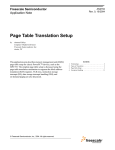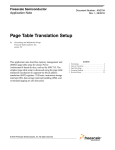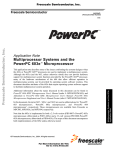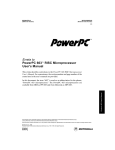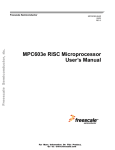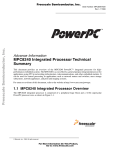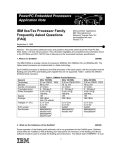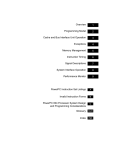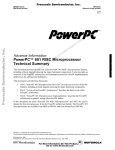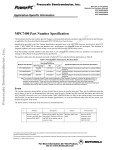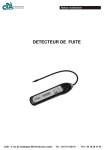Download MPC603e & EC603e Microprocessor User`s Manual, rev. 1
Transcript
Order Number: MPC603EUMAD/D Rev. 1, 10/2000 Semiconductor Products Sector ™ Errata to MPC603e & EC603e Microprocessor User’s Manual, rev. 1 This errata describes corrections to the MPC603e & EC603e RISC Microprocessor User’s Manual. For convenience, the section number and page number of the errata item in the user’s manual are provided. To locate any published updates for this document, refer to the world-wide web at http://www.motorola.com/semiconductors. This document contains information on a new product under development by Motorola. Motorola reserves the right to change or discontinue this product without © Motorola, Inc., 2000. All rights reserved. Section #/Page # 1.1.1, 1-6 2.1.1, 2-3 2 Changes The bus connecting the LSU to the GPRs should be 32 bits wide. Figure 2-1 in revision 1 of the published manual should be replaced by the following figure: MPC603e & EC603e Microprocessor User’s Manual, rev. 1 Section #/Page # Changes SUPERVISOR MODEL—OEA Configuration Registers USER MODEL—UISA General-Purpose Registers GPR0 Hardware Implementation Registers1 Processor Version Register Machine State Register HID0 SPR 1008 HID1 SPR 1009 MSR PVR SPR 287 Memory Management Registers GPR1 Instruction BAT Registers GPR31 Floating-Point Registers2 FPR0 FPR1 Software Table Search Registers1 Data BAT Registers IBAT0U SPR 528 DBAT0U SPR 536 DMISS SPR 976 IBAT0L SPR 529 DBAT0L SPR 537 DCMP SPR 977 IBAT1U SPR 530 DBAT1U SPR 538 HASH1 SPR 978 IBAT1L SPR 531 DBAT1L SPR 539 HASH2 SPR 979 IBAT2U SPR 532 DBAT2U SPR 540 IMISS SPR 980 IBAT2L SPR 533 DBAT2L SPR 541 ICMP SPR 981 IBAT3U SPR 534 DBAT3U SPR 542 RPA SPR 982 IBAT3L SPR 535 DBAT3L SPR 543 Segment Registers SDR1 FPR31 SR0 SDR1 SPR 25 SR1 Condition Register CR SR15 Floating-Point Status and Control Register2 FPSCR DAR SPR 1 Link Register LR SPR 8 SPR 9 USER MODEL—VEA TBL TBR 268 TBU TBR 269 DSISR SPR 18 Save and Restore SPRG0 SPR 272 SRR0 SPR 26 SPRG1 SPR 273 SRR1 SPR 27 SPRG2 SPR 274 SPRG3 SPR 275 Miscellaneous Registers Count Register CTR DSISR SPR 19 SPRGs XER XER Exception Handling Registers Data Address Register Time Base Facility (For Writing) TBL SPR 284 TBU SPR 285 Instruction Address Breakpoint Register1 IABR Decrementer DEC SPR 22 External Address Register (Optional) SPR 1010 EAR SPR 282 Notes: 1These registers are 603e–specific (PID6-603e and PID7v-603e) registers. They may not be supported by other PowerPC processors. 2Not supported on the EC603e microprocessor. MPC603e & EC603e Microprocessor User’s Manual, rev. 1 3 Section #/Page # 2.1.1, 2-4 Changes Add the following text after the first paragraph of the sub-bullet for Floating-point registers (FPRs): Before the stfd instruction is used to store the contents of an FPR to memory, the FPR must have been initialized after reset (explicitly loaded with any value) by using a floating point load instruction. 2.1.1, 2-5 Replace Table 2-1 with the following: Table 2-1. MSR[POW] and MSR[TGPR] Bits Bit Name 13 POW Description Power management enable (603e-specific) 0 Disables programmable power modes (normal operation mode). 1 Enables programmable power modes (nap, doze, or sleep mode). This bit controls the programmable power modes only; it has no effect on dynamic power management (DPM). MSR[POW] may be altered with an mtmsr instruction only. Also, when altering the POW bit, software may alter only this bit in the MSR and no others. The mtmsr instruction must be followed by a context-synchronizing instruction. See Chapter 9, “Power Management,” for more information on power management. 14 TGPR Temporary GPR remapping (603e-specific) 0 Normal operation 1 TGPR mode. GPR0–GPR3 are remapped to TGPR0–TGPR3 for use by TLB miss routines. The contents of GPR0–GPR3 remain unchanged while MSR[TGPR] = 1. Attempts to use GPR4–GPR31 with MSR[TGPR] = 1 yield undefined results. When this bit is set, all instruction accesses to GPR0–GPR3 are mapped to TGPR0–TGPR3, respectively. The TGPR bit is set when either an instruction TLB miss, data TLB miss on load, or data TLB miss on store exception is taken. The TGPR bit is cleared by an rfi instruction. 2.1.2.1, 2-8 Replace Table Table 2-2 with the HID0 bits descriptions as follows: Table 2-2. HID0 Bit Functions Bit 4 Name Function 0 EMCP Enable MCP. The primary purpose of this bit is to mask out further machine check exceptions caused by assertion of MCP, similar to how MSR[EE] can mask external interrupts. 0 Masks MCP. Asserting MCP does not generate a machine check exception or a checkstop. 1 Asserting MCP causes checkstop if MSR[ME] = 0 or a machine check exception if ME = 1. 1 — Reserved 2 EBA Enable/disable 60x bus address parity checking 0 Disables address parity checking. 1 Allows a address parity error to cause a checkstop if MSR[ME] = 0 or a machine check exception if MSR[ME] = 1. EBA and EBD allow the processor to operate with memory subsystems that do not generate parity. 3 EBD Enable 60x bus data parity checking 0 Disables data parity checking. 1 Allows a data parity error to cause a checkstop if MSR[ME] = 0 or a machine check exception if MSR[ME] = 1. EBA and EBD allow the processor to operate with memory subsystems that do not generate parity. 4 BCLK CLK_OUT output enable and clock type selection. Used in conjunction with HID0[ECLK] and the HRESET signal to configure CLK_OUT. See Table 2-3. MPC603e & EC603e Microprocessor User’s Manual, rev. 1 Section #/Page # Changes Table 2-2. HID0 Bit Functions (Continued) Bit Name Function 5 EICE Enables in-circuit emulator outputs for pipeline tracking. See Section 7.2.11, “Pipeline Tracking Support,” for more information. 6 ECLK CLK_OUT output enable and clock type selection. Used in conjunction with HID0[BCLK] and the HRESET signal to configure CLK_OUT. See Table 2-3. 7 PAR Disable precharge of ARTRY. 0 Precharge of ARTRY enabled 1 Alters bus protocol slightly by preventing the processor from driving ARTRY to high (negated) state. If this is done, the system must restore the signals to the high state. 8 DOZE1 Doze mode enable. Operates in conjunction with MSR[POW]. 0 Doze mode disabled. 1 Doze mode enabled. Doze mode is invoked by setting MSR[POW] while this bit is set. In doze mode, the PLL, time base, and snooping remain active. 9 NAP1 Nap mode enable. Operates in conjunction with MSR[POW]. 0 Nap mode disabled. 1 Nap mode enabled. Doze mode is invoked by setting MSR[POW] while this bit is set. In nap mode, the PLL and the time base remain active. 10 SLEEP1 Sleep mode enable. Operates in conjunction with MSR[POW]. 0 Sleep mode disabled. 1 Sleep mode enabled. Sleep mode is invoked by setting MSR[POW] while this bit is set. QREQ is asserted to indicate that the processor is ready to enter sleep mode. If the system logic determines that the processor may enter sleep mode, the quiesce acknowledge signal, QACK, is asserted back to the processor. Once QACK assertion is detected, the processor enters sleep mode after several processor clocks. At this point, the system logic may turn off the PLL by first configuring PLL_CFG[0–3] to PLL bypass mode, then disabling SYSCLK. 11 DPM1 Dynamic power management enable. 0 Dynamic power management is disabled. 1 Functional units enter a low-power mode automatically if the unit is idle. This does not affect operational performance and is transparent to software or any external hardware. 12–15 — Reserved 16 ICE2 Instruction cache enable 0 The instruction cache is neither accessed nor updated. All pages are accessed as if they were marked cache-inhibited (WIM = X1X). Potential cache accesses from the bus (snoop and cache operations) are ignored. In the disabled state for the L1 caches, the cache tag state bits are ignored and all accesses are propagated to the L2 cache or bus as single-beat transactions. For those transactions, however, CI reflects the original state determined by address translation regardless of cache disabled status. ICE is zero at power-up. 1 The instruction cache is enabled 17 DCE2 Data cache enable 0 The data cache is neither accessed nor updated. All pages are accessed as if they were marked cache-inhibited (WIM = X1X). Potential cache accesses from the bus (snoop and cache operations) are ignored. In the disabled state for the L1 caches, the cache tag state bits are ignored and all accesses are propagated to the L2 cache or bus as single-beat transactions. For those transactions, however, CI reflects the original state determined by address translation regardless of cache disabled status. DCE is zero at power-up. 1 The data cache is enabled. MPC603e & EC603e Microprocessor User’s Manual, rev. 1 5 Section #/Page # Changes Table 2-2. HID0 Bit Functions (Continued) Bit Name Function 18 ILOCK2 Instruction cache lock 0 Normal operation 1 Instruction cache is locked. A locked cache supplies data normally on a hit, but are treated as a cache-inhibited transaction on a miss. On a miss, the transaction to the bus or the L2 cache is single-beat, however, CI still reflects the original state as determined by address translation independent of cache locked or disabled status. To prevent locking during a cache access, an isync instruction must precede the setting of ILOCK. 19 DLOCK2 Data cache lock. 0 Normal operation 1 Data cache is locked. A locked cache supplies data normally on a hit but is treated as a cacheinhibited transaction on a miss. On a miss, the transaction to the bus or the L2 cache is singlebeat, however, CI still reflects the original state as determined by address translation independent of cache locked or disabled status. A snoop hit to a locked L1 data cache performs as if the cache were not locked. A cache block invalidated by a snoop remains invalid until the cache is unlocked. To prevent locking during a cache access, a sync instruction must precede the setting of DLOCK. 20 ICFI2 Instruction cache flash invalidate 0 The instruction cache is not invalidated. The bit is cleared when the invalidation operation begins (usually the next cycle after the write operation to the register). The instruction cache must be enabled for the invalidation to occur. 1 An invalidate operation is issued that marks the state of each instruction cache block as invalid without writing back modified cache blocks to memory. Cache access is blocked during this time. Bus accesses to the cache are signaled as a miss during invalidate-all operations. Setting ICFI clears all the valid bits of the blocks and the PLRU bits to point to way L0 of each set. For 603e processors, the proper use of the ICFI and DCFI bits is to set them and clear them with two consecutive mtspr operations. 21 DCFI2 Data cache flash invalidate 0 The data cache is not invalidated. The bit is cleared when the invalidation operation begins (usually the next cycle after the write operation to the register). The data cache must be enabled for the invalidation to occur. 1 An invalidate operation is issued that marks the state of each data cache block as invalid without writing back modified cache blocks to memory. Cache access is blocked during this time. Bus accesses to the cache are signaled as a miss during invalidate-all operations. Setting DCFI clears all the valid bits of the blocks and the PLRU bits to point to way L0 of each set. For 603e processors, the proper use of the ICFI and DCFI bits is to set them and clear them with two consecutive mtspr operations. 22–23 — 24 IFEM 25–26 — 6 Reserved Instruction fetch enable M (PID7v-603e only). Enables the M bit on the bus. Used for instruction fetches. Reserved 27 FBIOB Force branch indirect on bus. 0 Register indirect branch targets are fetched normally 1 Forces register indirect branch targets to be fetched externally 28 ABE2 Address broadcast enable—controls whether certain address-only operations (such as cache operations) are broadcast on the 60x bus. 0 Address-only operations affect only local caches and are not broadcast. 1 Address-only operations are broadcast on the 60x bus.Affected instructions are dcbi, dcbf, and dcbst. Note that these cache control instruction broadcasts are not snooped by the PID7v-603e. Refer to Section 3.2.3, “Data Cache Control,” for more information. MPC603e & EC603e Microprocessor User’s Manual, rev. 1 Section #/Page # Changes Table 2-2. HID0 Bit Functions (Continued) Bit Name 29–30 — 31 1 2 Function Reserved NOOPTI No-op the data cache touch instructions. 0 The dcbt and dcbtst instructions are enabled. 1 The dcbt and dcbtst instructions are no-oped globally. See Chapter 9, “Power Management,” for more information. See Chapter 3, “Instruction and Data Cache Operation,” for more information 2.1.2.1, 2-8 Also, add to this section the following: Table 2-3, the paragraph preceding it, and the sentence immediately following it. Table 2-3 shows how HID0[BCLK], HID0[ECLK], and HRESET are used to configure CLK_OUT. See Section 7.2.12.2, “Test Clock (CLK_OUT)—Output,” for more information. Table 2-3. HID0[BCLK] and HID0[ECLK] CLK_OUT Configuration HRESET HID0[ECLK] HID0[BCLK] CLK_OUT Asserted x x Bus Negated 0 0 High impedance Negated 0 1 Core clock frequency Negated 1 0 Bus Negated 1 1 Core clock frequency HID0 can be accessed with mtspr and mfspr using SPR1008. Then, after Figure 2-3, add the following: HID1 can be accessed with mfspr using SPR1009. 2.1.2.7, 2-12 Remove this section. The Run_N counter is not an SPR. 2.3.5.3, 2-41 Add the following text to the end of this section: Note that incoherency may occur if the following sequence of accesses hits the same cache block: a write-through, a dcbz instruction, a snoop. This occurs when the logical address for the dcbz and the write-through store are different but aliased to the same physical page. MPC603e & EC603e Microprocessor User’s Manual, rev. 1 7 Section #/Page # Changes To avoid potential adverse effects, dcbz should not address writethrough memory that can be accessed through multiple logical addresses. Explicit store instructions that write all zeroes should be used instead. Note that broadcasting a sequence of dcbz instructions may cause snoop accesses to be retried indefinitely, which may cause the snoop originator to time out or may cause the snooped transaction to not complete. This can be avoided by disabling the broadcasting of dcbz by marking the memory space being addressed by the dcbz instruction as not global in the BAT or PTE. 2.3.5.4, 2-42 Replace the first four sentences of this section with the following: The eciwx instruction provides an alternative way to map special devices. The MMU translation of the EA is not used to select the special device, as it is used in loads and stores. Rather, it is used as an address operand that is passed to the device over the address bus. Four other signals (the burst and size signals on the 60x bus) are used to select the device; these four signals output the 4-bit resource ID (RID) field in the EAR register. The eciwx instruction also loads a word from the data bus that is output by the special device. 2.3.6.3.1, 2-44 The section should be completely replaced with the following: The supervisor-level cache management instruction in the PowerPC architecture, dcbi, should not be used on the 603e. The user-level dcbf instruction, described in Section 2.3.5.3, "Memory Control Instructions—VEA," and in Section 3.7, "Cache Control Instructions," should be used when the program needs to invalidate cache blocks. Note that the dcbf instruction causes modified blocks to be flushed to system memory if they are the target of a dcbf instruction whereas, by definition in the PowerPC architecture, the dcbi instruction only invalidates modified blocks. 3.1.3.2, 3-4 Change the last sentence of the paragraph to the following: To prevent the cache from being enabled or disabled in the middle of a data access, an isync instruction should be issued before changing the value of ICE. 3.2.3.2, 3-6 Change the last sentence of the first paragraph to the following: To prevent the cache from being enabled or disabled in the middle of a data access, a sync instruction should be issued before changing the value of DCE. 4.1, 4-3 The parenthetical clause in the second sentence of the first bullet should be “... (that is, all enabled floating-point exceptions are always precise on the 603e).” 4.1, 4-4 Figure 4-1 should be re-labeled as Table 4-1. 8 MPC603e & EC603e Microprocessor User’s Manual, rev. 1 Section #/Page # 4.1, 4-5 Changes At the end of the first sentence in the description of the floating-point unavailable exception, change “...when the floating-point available bit is disabled...” to “...when the floating-point available bit is cleared...” Also, change “... Note that the EC603e microprocessor... execution of a floating-point...” to “Note that the EC603e microprocessor... execution of any floating-point...” Also, the description for instruction translation miss should change from “... miss exception is caused when an effective address for an...” to “... miss exception is caused when the effective address for an...” 4.1, 4-6 The descriptions for Data load translation miss and Data store translation miss should change from “... miss exception is caused when an effective address for a...” to “... miss exception is caused when the effective address for a...” 4.2, 4-13 In Table 4-5 change the description of the FP bit from“...The processor prevents dispatch of floating-point instructions, including floatingpoint loads, stores, and moves, default...” to “...The processor prevents dispatch of floating-point instructions, including floating-point loads, stores, and moves; default...” Bit 24 is “Reserved” rather than “Reserved. Full Function.” 4.2.2, 4-15 The first sentence of step 4 should be “The MSR is set as described in Table 4-7.” 4.5, 4-17 In Table 4-7, the setting for the IP bit in the System reset row should be a 1 instead of the “—” shown in the table. 4.5, 4-18 The first note for Table 4-7 should read as “The floating-point available bit is always cleared to 0 on the EC603e microprocessor.” 4.5.1.2, 4-20 The first sentence in the second paragraph should read as follows: Unlike a hard reset, no registers or latches are initialized; however, the instruction cache is disabled (HID0[ICE] = 0]. The second sentence in the second paragraph should read as follows: After SRESET is recognized as asserted, the processor beings fetching instructions from the system reset routine at offset 0x0100. The third sentence should read as follows: When a soft reset occurs, registers are set as shown in Table 4-9 and HID0[ICE] is cleared. MPC603e & EC603e Microprocessor User’s Manual, rev. 1 9 Section #/Page # 4.5.5, 4-25 Changes Replace the second sentence in the second paragraph with the following: The 603e allows the next instruction in program order to complete, including handling any exceptions that instruction may generate. However, the 603e blocks subsequent instructions from completing and allows any outstanding stores to occur to system memory. 4.5.5, 4-26 The last sentence of this section should be appended as follows: The interrupt handler must send a command to the device that asserted INT, acknowledging the interrupt and instructing the device to negate INT before the handler re-enables recognition of external interrupts. 4.5.6.1.1, 4-28 Remove the heading “4.5.6.1.1 Page Address Translation Access.” The text that follows this heading should just be part of section 4.5.6.1. 4.5.12, 4-34 In Table 4-16, the KEY bit was omitted and the polarity of bit 15 was reversed. Therefore, replace the SRR1 row with the following: . Table 4-16. Instruction and Data TLB Miss Exceptions— Register Settings (partial) SRR1 5.1.7, 5-16 5.1.8, 5-18 5.1.8, 5-18 0–3 4–11 12 Loaded from condition register CR0 field Cleared KEY. Key for TLB miss (SR[Ks] or SR[Kp], depending on whether the access is a user or supervisor access). 13 D/I. Data or instruction access 0 = Data TLB miss 1 = Instruction TLB miss 14 WAY. Next TLB set to be replaced (set per LRU) 0 = Replace TLB associativity set 0 1 = Replace TLB associativity set 1 15 S/L. Store or load data access 0 = Data TLB miss on load 1 = Data TLB miss on store (or C = 0) 16–31 Loaded from MSR[16–31] In Table 5-4, delete the sixth row (lwarx or stwcx. with W = 1). In Table 5-5, add the following paragraph at the end of the tlbie description. Software must ensure that instruction fetches or memory references to the virtual pages specified by the tlbie instruction have been completed prior to executing the tlbie instruction. In Table 5-5, add the following sentence at the end of the tlbsync description. For a complete description of the TLBISYNC signal, refer to Section 8.8.2, “TLBSYNC Input.” 10 MPC603e & EC603e Microprocessor User’s Manual, rev. 1 Section #/Page # 5.3, 5-20 Changes Replace the Implementation Note for Block Address Translation with: The 603e BAT registers are not initialized by the hardware after the power-up or reset sequence. Consequently, all valid bits in both instruction and data BAT areas must be explicitly cleared before setting any BAT area for the first time and before enabling translation. Also, note that software must avoid overlapping blocks while updating a BAT area or areas. Even if translation is disabled, multiple BAT area hits (with the valid bits set) can corrupt the remaining portion (any bits except the valid bits) of the BAT registers. 5.4.3.1, 5-26 5.4.3.1, 5-26 5.4.3.1, 5-27 5.4.4, 5-29 Thus, multiple BAT hits (with valid bits set) are considered a programming error whether translation is enabled or disabled and can lead to unpredictable results if translation is enabled (or if translation is disabled, when translation is eventually enabled). For the case of unused BATs (if translation is to be enabled) it is sufficient precaution to simply clear the valid bits of the unused BAT entries.” The second part of the second sentence in the first paragraph of that page should be deleted so that the sentence should read as follows: ITLB miss exception conditions are reported when there are no more instructions to be dispatched or retired (the pipeline is empty). The very last sentence on this page should be edited as follows: In order to uniquely identify a TLB entry as the required PTE, the TLB entry also contains... The phrase, “the valid entries are loaded and” should be deleted from the second sentence in the last paragraph of section 5.4.3.1. Figure 5-8 in the published manual incorrectly shows the loopback arrow on the left side pointing to the node above the word ‘otherwise’. Replace Figure 5-8 with the following: MPC603e & EC603e Microprocessor User’s Manual, rev. 1 11 Section #/Page # Changes Effective address generated (See Figure 5-6) otherwise Instruction fetch with N-bit set in segment descriptor (no-execute) Page address translation Generate 52-bit virtual address from segment descriptor Compare virtual address with TLB entries TLB hit case dcbz instruction with W or I = 1 otherwise Alignment exception Check page memory protection violation conditions (See The Programming Environments Manual) Access permitted Store access with PTE [C] = 0 Page table search operation Access prohibited otherwise Page memory protection violation PA[0–31]←RPN||A[20–31] (See Figure 5-9) Continue access to memory subsystem with WIMG- bits from PTE Figure 5-8. Page Address Translation Flow—TLB Hit 12 MPC603e & EC603e Microprocessor User’s Manual, rev. 1 (See The Programming Environments Manual) Section #/Page # 5.5.2.2.2, 5-46 Changes Replace the doISI segment with the following: doISI: isi1 mfsprr3, srr1 # get srr1 andi.r2, r3, 0xffff# clean srr1 addisr2, r2, 0x4000# or in srr1<1> = 1 to flag pte not found mtctrr0 # restore counter mtsprsrr1, r2# set srr1 mfmsrr0 # get msr xorisr0, r0, 0x8000# flip the msr<tgpr> bit mtcrf0x80, r3# restore CR0 mtmsrr0 # flip back to the native gprs bvec400 # go to instr. access exception # 5.5.2.2.2, 5-47 Replace the third line of the dm1 segment with the following: bdnzf0, dm1# dec count br if cmp ne and if count not zero 5.5.2.2.2, 5-49 Replace the comment of the second line of the chk0 segment with the following: andis.r3,r3,0x0008 # test the KEY bit (SRR1-bit 12) 5.5.2.2.2, 5-49 Replace the second line in the chk2 segment with the following sthr1, 6(r2) # update page table 5.5.2.2.2, 5-50 beqdsi2: Replace the third line from the top of the page with the following # if little endian then: 8.2.1, 8-8 The second part of the DBG bullet should be edited to read as follows: “The DBB signal is driven by the current bus master. DRTRY is only driven from the bus; ARTRY is driven from the bus, but only for the address bus tenure...” 8.3.2.2.1, 8-13 The cross references at the end of this section should be to Table 7-1 and Table 7-2, instead of Table 8-1 and Table 8-2. 8.3.2.4, 8-17 The fifth entry in the TSIZ[0–2] column (second access for the second misaligned entry) should be 010 instead of 011. 8.3.3, 8-20 Replace sentences 3–5 with the following: Although AACK can be asserted as early as the bus clock cycle following TS (see Figure 8-7), which allows a minimum address tenure of two bus cycles when the 603e clock is configured for 1:1 or 1.5: 1 processor-to-bus clock mode, the ARTRY snoop response cannot be determined in the minimum allowed address tenure period. Thus in a system with two or more 603e processors using 1:1 or 1.5:1 clock mode, AACK must not be asserted until the third clock of the address tenure (one address wait state) to allow the snooping 603e processors an opportunity to assert ARTRY on the bus. For other clock configurations (2:1, 2.5:1, 3:1, 3.5:1, and 4:1), the ARTRY MPC603e & EC603e Microprocessor User’s Manual, rev. 1 13 Section #/Page # Changes snoop response can be determined in the minimum address tenure period, and AACK may be asserted as early as the second bus clock of the address tenure. 8.4.4.1, 8-27 Insert a new section heading, 8.4.4.2, “Normal Burst Termination,” immediately after Figure 8-10. 8.7.4, 8-42 Replace the first sentence of the second paragraph with the following: The system quiesce state is entered by configuring the processor to assert the QREQ output. 8.8.1, 8-42 The first sentence of the second paragraph should read as follows: The reservation (RSRV) output signal is driven synchronously with the bus clock and reflects the status of the reservation coherency bit in the reservation address buffer (see Section 3.9, “Instruction and Data Cache Operation,” for more information). 9.2, 9-2 In the third sentence of the last paragraph on this page, the SMI should have an overbar (SMI). 9.2.1.4, 9-4 Change the fourth second-level bullet under the “Nap mode sequence” bullet to the following: The processor enters nap mode after several processor clocks. 9.2.1.5, 9-5 14 The last sub-bullet should have overbars on INT and SMI. MPC603e & EC603e Microprocessor User’s Manual, rev. 1 Section #/Page # Changes MPC603e & EC603e Microprocessor User’s Manual, rev. 1 15 DigitalDNA and Mfax are trademarks of Motorola, Inc. The PowerPC name, the PowerPC logotype, and PowerPC 603e are trademarks of International Business Machines Corporation used by Motorola under license from International Business Machines Corporation. Information in this document is provided solely to enable system and software implementers to use PowerPC microprocessors. There are no express or implied copyright licenses granted hereunder to design or fabricate PowerPC integrated circuits or integrated circuits based on the information in this document. Motorola reserves the right to make changes without further notice to any products herein. Motorola makes no warranty, representation or guarantee regarding the suitability of its products for any particular purpose, nor does Motorola assume any liability arising out of the application or use of any product or circuit, and specifically disclaims any and all liability, including without limitation consequential or incidental damages. “Typical” parameters can and do vary in different applications. All operating parameters, including “Typicals” must be validated for each customer application by customer’s technical experts. Motorola does not convey any license under its patent rights nor the rights of others. Motorola products are not designed, intended, or authorized for use as components in systems intended for surgical implant into the body, or other applications intended to support or sustain life, or for any other application in which the failure of the Motorola product could create a situation where personal injury or death may occur. Should Buyer purchase or use Motorola products for any such unintended or unauthorized application, Buyer shall indemnify and hold Motorola and its officers, employees, subsidiaries, affiliates, and distributors harmless against all claims, costs, damages, and expenses, and reasonable attorney fees arising out of, directly or indirectly, any claim of personal injury or death associated with such unintended or unauthorized use, even if such claim alleges that Motorola was negligent regarding the design or manufacture of the part. Motorola and are registered trademarks of Motorola, Inc. Motorola, Inc. is an Equal Opportunity/Affirmative Action Employer. Motorola Literature Distribution Centers: USA/EUROPE: Motorola Literature Distribution; P.O. Box 5405; Denver, Colorado 80217; Tel.: 1-800-441-2447 or 1-303-675-2140; World Wide Web Address: http://ldc.nmd.com/ JAPAN: Nippon Motorola Ltd SPD, Strategic Planning Office 4-32-1, Nishi-Gotanda Shinagawa-ku, Tokyo 141, Japan Tel.: 81-3-5487-8488 ASIA/PACIFIC: Motorola Semiconductors H.K. Ltd Silicon Harbour Centre 2, Dai King Street Tai Po Industrial Estate Tai Po, New Territories, Hong Kong Mfax™: [email protected]; TOUCHTONE 1-602-244-6609; US & Canada ONLY (800) 774-1848; World Wide Web Address: http://sps.motorola.com/mfax INTERNET: http://motorola.com/sps Technical Information: Motorola Inc. SPS Customer Support Center 1-800-521-6274; electronic mail address: [email protected]. Document Comments: FAX (512) 895-2638, Attn: RISC Applications Engineering. World Wide Web Addresses: http://www.motorola.com/PowerPC http://www.motorola.com/netcomm http://www.motorola.com/Coldfire MPC603EUMAD/D
















